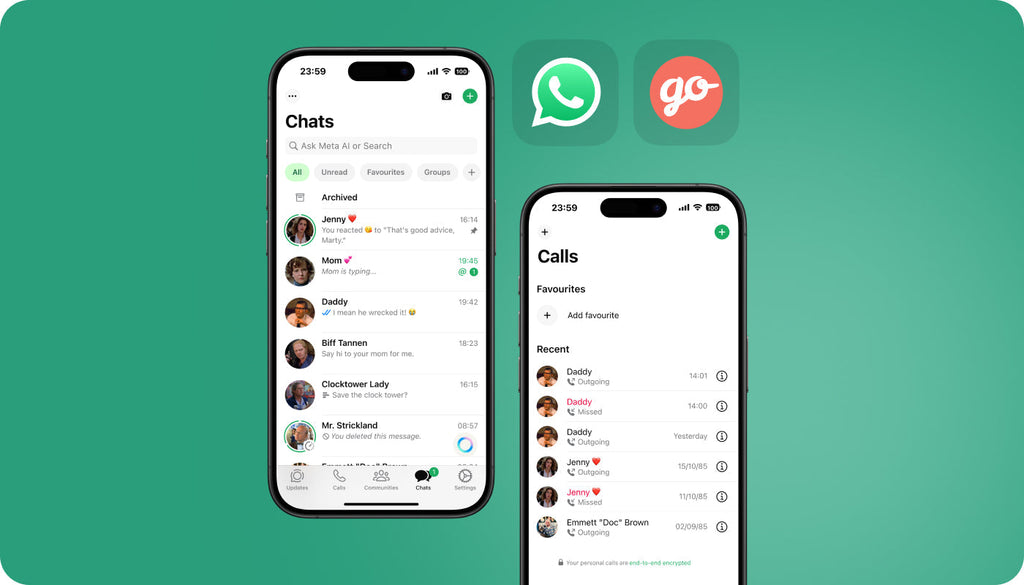Best Internet Solution - Combining Local SIM Cards with International Data SIM Card
When you go abroad, it’s important to have an uninterrupted connection to keep in touch with family and friends and access the web whenever it’s needed. Traveling internationally, you can choose from many connectivity solutions to use data in a foreign place. This includes staying with your local connectivity provider and paying for data roaming. However, there are more popular and affordable options available, like a local SIM card of your destination country or an international data SIM card that keeps you covered worldwide.
Rather than paying expensive roaming charges, we recommend you to try using an international data SIM card and a local SIM card. Let’s discuss the key advantages to use each of them and decide when it’s the best time to switch from one solution to another.
Before we start the discussion, let’s mention the topics that are discussed in this article:
Data Roaming: Advantages & Disadvantages
Travel with Local and International Data SIM Cards
Data Roaming: Advantages & Disadvantages

Data roaming is using the Internet and phone data of your local SIM card operator in a foreign country. As a rule, data roaming charges are more expensive than the cost of using the same services when you are at home.
In simple words, when you use your smartphone in your country, you pay a fixed monthly fee to your local phone operator. When you go abroad, you are provided with a different data plan in order for you to be able to make phone calls and browse the web without switching a SIM card in your phone.
Roaming services consist of your local connectivity provider contacting other companies abroad to provide you with the connectivity services. The rates are rather expensive because you end up paying several companies to get an uninterrupted service no matter where you travel.
Using roaming data is good as long as you have enough money to pay for it. Besides, there are several advantages of using roaming services, like:
- You do not need to change a phone number when you leave.
- It’s easy to use. All that it takes is activating the function on your phone to start using it when you go abroad.
- The destination network is selected automatically.
- If you are in a country that is a member of the European Union, then roaming rates won’t apply.
Besides a set of advantages, there are also several drawbacks of using roaming services.
- It’s more expensive than using a Travel SIM. For example, the rate of 10GB of international data roaming from AT&T is $100 and expires in 30 days. But if you choose an International Data SIM card, 10GB of high-speed data will cost you $61 and remain valid forever. So do the math!
- It can be an issue to get in touch with a customer support representative.
- It takes some time and effort to switch to a different network and connectivity services provider on roaming.
Basically, these are the major things that you need to keep in mind when you decide to travel with your local SIM card and pay for the roaming services to your connectivity provider.
Next come the two connectivity solutions that are more popular among international travelers who know the real value for money. Let’s see what makes using an international data SIM card and a local SIM so special, and when it’s time to switch from one solution to another in a foreign country.
International Data SIM Cards
For business travelers and those vacationers who dip in and out of countries on short trips several times per year, international data SIM cards are a sensible choice. This is a cheaper option than paying roaming charges or buying a local SIM card every time you arrive in a foreign place.
An international data SIM card is worth considering for short-time vacationers who take a few trips a year. Such connectivity solutions also make sense for those who hop through several countries in a hurry.

By means of an international data SIM card, you can use your smartphone or any other SIM-enabled device in more than one country. For example, you plan a trip to Europe to visit 3 countries one after another. You are going to see the Eiffel Tower in France, the Berlin Wall in Germany, and the Picasso Museum in Spain. The possibility to use one SIM card in many countries is the major advantage of such connectivity solutions.
International data SIM cards are programmed to work on multiple networks in different countries around the globe. Additionally, there are lots of other advantages of using international data SIM cards for your international vacations:
- An international data SIM card is cheaper because it connects your device to local networks.
- As a rule, international data SIM cards are prepaid, which means they already include a certain amount of international data.
- With a pay-as-you-go SIM card, you are always in control of how much money you spend and how much is still on your balance.
- To never run out of money on the balance, you can activate an Auto Refill option for your account and you will have uninterrupted connectivity.
- Unlike local SIM cards, the data of an international data SIM card remains valid forever. For example, with Keepgo it’s enough to refill your balance once a year and use the services without an expiry date. On top of that, if there are megabytes of data remaining on your balance even after you come back home, they won’t expire. You can continue using your data the next time you go abroad.
Local SIM Cards
When you arrive in a foreign country, buying a local SIM card is one of the cheapest ways to stay connected. A local SIM card works only within a certain geographic area. For example, if you come to the USA and buy a local SIM card there, it won’t work in Spain. So, you will need to change for a different local SIM or start using roaming data.
Before you decide to start using a local SIM card, there are a few major considerations that you need to keep in mind:
- Some countries (like India and Japan to name a few) require you to provide proof of your residency to buy a local SIM card.
- This is also important to do some homework in advance and check if your device is compatible with the frequency bands used in the country.
- In most countries, you can buy a local SIM card right in the airport. However, it is more expensive than getting one from a local telecom provider or an official reseller.
The cost of a local SIM card varies depending on the country that you visit and the connectivity provider that you choose. An average cost of 4G data and calls in a foreign country make up $20 per month. This is cheaper than the price you would pay for roaming services.

There are two sides of a coin. Together with cost-effective rates and a number of advantages, using a local SIM card has some drawbacks:
- If your family or friends decide to call you, they will be paying to contact an international phone number.
- If you don’t know the language of the country that you visit, it can be difficult to find a reseller shop and refill your balance.
- If you do not refill a local SIM card in a year or less (depending on the chosen connectivity provider), then it simply won’t work the next time you visit the same country. Some have plans that are for only a week or a month and some SIM cards expire so you won't be able to use it if you come back again.
Travel with Local and International Data SIM Cards
Finally, how to travel the world and forget about connectivity issues?
When you start planning a trip abroad, you need to feel certain that your phone won’t be offline. Roaming will work everywhere your local phone provider can reach. However, this can hardly be called the cheapest connectivity solution for international travels. This is when international data SIM cards and local SIMs of your destination country come into play.
Every time you arrive in a new country, you need some time to look around and find a place where you can buy a local SIM card. So, using an international data SIM is the best way to have a working smartphone when you step off the plane to tell your Airbnb host that you’ve arrived and order a taxi.
An international data SIM card can be useful for your first several days somewhere new. It will connect you to a local connectivity provider and you won’t need to buy a local SIM card at a more expensive cost at the airport. Moreover, you will have some time to research the market and select a local SIM from a carrier that offers the best rates.




